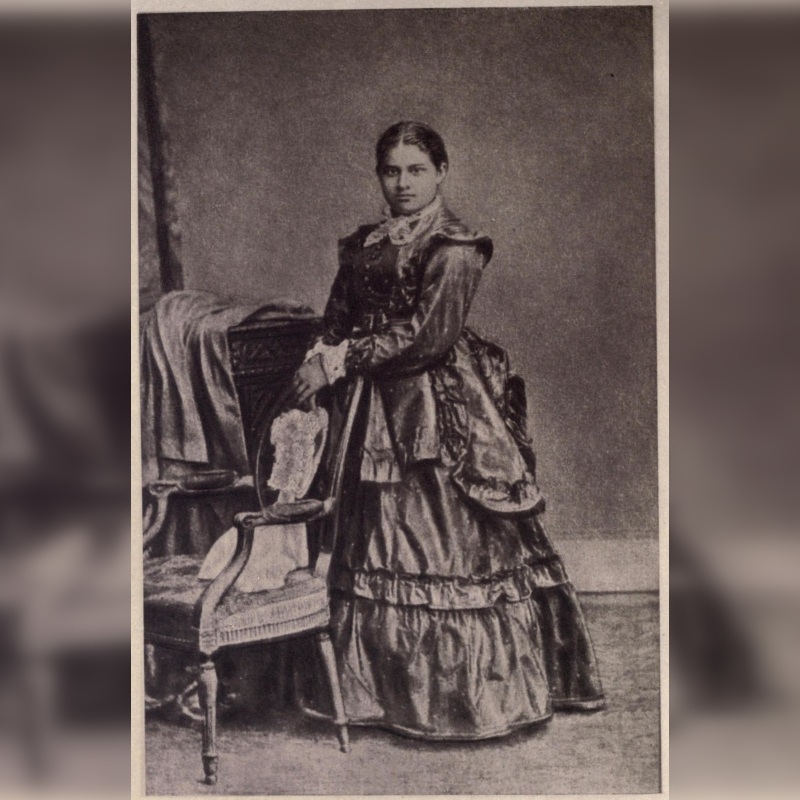Bengali writer Toru Dutt is often considered the first Indian poetess to write in French and English. At a time when Indian writers were facing a lot of criticism from English litterateurs, Dutt’s work was not only appreciated but even republished. Although she died at the tender age of 21, Dutt’s achievements are significant even today. (Photo Courtesy: Public Domain)
Toru Dutt (1856–1877)—poet, novelist, essayist, translator and polyglot—was an outstanding pioneer in the history of Indian literature. Born as Torulata Dutt on March 4, 1856 to the illustrious and wealthy Dutt family of Rambagan, Calcutta (now Kolkata), she was the youngest daughter of Govin Chunder Dutt and Kshetramoni.
The Dutt family, renowned for its aristocracy, progressive Westernised outlook and literary leanings, was a gifted product of the cultural renaissance of mid-nineteenth-century Bengal. Her father was a noted linguist and a published poet writing in English while her mother was a cultured and intelligent woman with a literary bent of mind. Toru’s uncles and cousins were also prolific writers of prose and poetry in English. The Dutt Family Album, published in London in 1870 by Govin Chunder Dutt, bears collective evidence of the family’s poetic efforts. Govin Chunder’s three children—Abju, Aru and Toru—were first educated at home by private English tutors.[i] They had an idyllic childhood, dividing their time between their city residence at Rambagan and their country or ‘garden’ house at Baugmaree.
Also Read | Verses for a Home Foregone: Four Poets on Exile and Being Refugees
In 1862—when Toru was six—the Dutts converted to Christianity from Hinduism. Three years later, the happiness of the close-knit family was shattered when Abju, the eldest son, died at the age of 14. Deeply aggrieved, Govin Chunder, along with his wife and two daughters, left for Europe in 1869 with the intention of settling there. He wanted his gifted daughters to see the world and receive the best of Western education.
They sailed to France, where Aru and Toru attended a French school at Nice for a few months. They studied French and spent time in Paris and Boulogne before moving to England in 1870. Along with their studies of French language and literature, the young girls began to translate French poetry into English. The family spent a year in London, where Aru and Toru studied music and history. In 1871, the Dutts moved to Cambridge where, for the next two years, Aru and Toru attended the ‘Lectures for Ladies’ series set up by liberal educationists like Millicent Garrett Fawcett and Henry Sidgwick. In Cambridge, Toru met Mary E. Martin, with whom she carried on a close friendship, mostly through letters, till her own death. In September 1873, the failing health of the two young daughters forced the Dutts to return to Calcutta.[ii]
The four years that the Dutt girls spent abroad were the happiest and the most liberating of their lives. After their return to Bengal, Aru and Toru tried to write their way out of the loneliness and the stifling atmosphere they experienced in Calcutta. However, in 1874, the 23-year-old Aru—Toru’s elder sister, constant companion and literary soulmate—died of consumption. Aru’s death put an end to their wished-for literary companionship, and Toru, now all alone, sought refuge in her books. She took to reading and writing with a new intensity.
Also Read | Shaping a Modern Kerala: Sahodaran’s Poetry of Fraternity, Liberty and Equality
Over the next three years, Toru produced an impressive collection of poetry and prose. She contributed regularly to the ‘Poet’s Corner’ of The Bengal Magazine and The Calcutta Review, publishing a series of English translations of French poetry between March 1874 and March 1877. She also wrote ‘An Eurasian Poet’ and two essays on the French Romantic poets Leconte de Lisle and Joséphin Soulary in 1874. In A Scene from Contemporary History, published in The Bengal Magazine (June–July 1875), Toru translated two political speeches by Victor Hugo and M. Adolphe Thiers.[iii] She also wanted to translate the French writer Clarisse Bader’s book La Femme dans L'Inde Antique (Women in Ancient India) into English, as her correspondence with Bader shows, but her ailing health prevented it. The intensity of her literary activities during this time as well as the urgency expressed in her letters to Mary Martin show that Aru’s death and her own failing health had perhaps given her a premonition of her own approaching end. This proved to be true and Toru, destined to die young like her beloved siblings, drew her last breath on August 30, 1877, after suffering from tuberculosis.
Additional Reading | A Language of Heterogeneity: The Poetry of Namdeo Dhasal
The only work that was published during Toru’s lifetime was A Sheaf Gleaned in French Fields (1876). This was a collection of English translations of French poetry that Toru had begun with her elder sister, and was published by the Saptahik Sambad Press in Calcutta without any preface or introduction. Toru had read Edmund Gosse’s appreciative review of the book in The Examiner of August 1876, but did not live to see the second expanded edition her father published in 1878 along with a memoir of her, or the illustrious third edition of nearly 200 poems published by Messrs Kegan Paul in 1880 that had a foreword by Arthur Symons and a frontispiece of Toru and Aru.
Toru also left her only English novel, Bianca, or The Young Spanish Maiden, unfinished. Bianca was later published serially in The Bengal Magazine from January to April 1878. Toru’s French novel, Le Journal de Mademoiselle d’Arvers, was posthumously published in France in 1879 with an introduction by Clarisse Bader. Ancient Ballads and Legends of Hindustan, comprising Toru’s original poems, poetic transcreations and adaptations from Sanskrit literature and Bengali tales, was published posthumously by Messrs Kegan Paul in London in 1882 with an introductory memoir by Edmund Gosse on Toru’s life and works.
This article was also published on Scroll.












